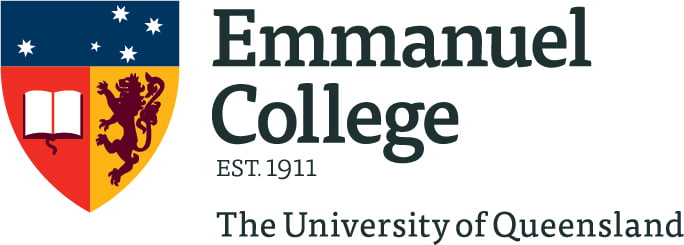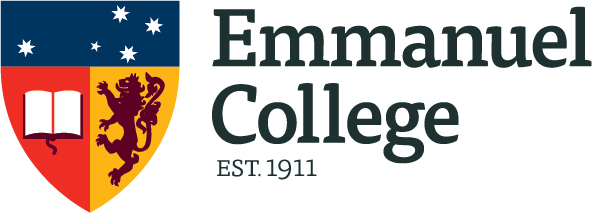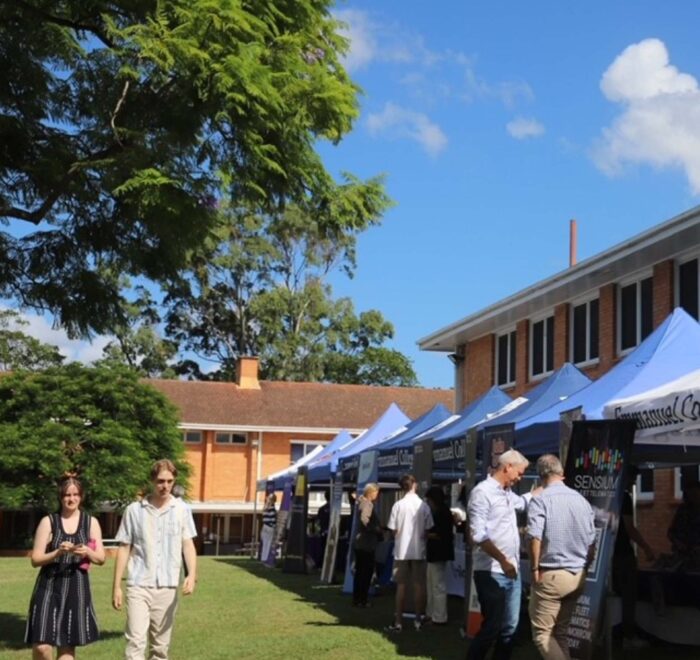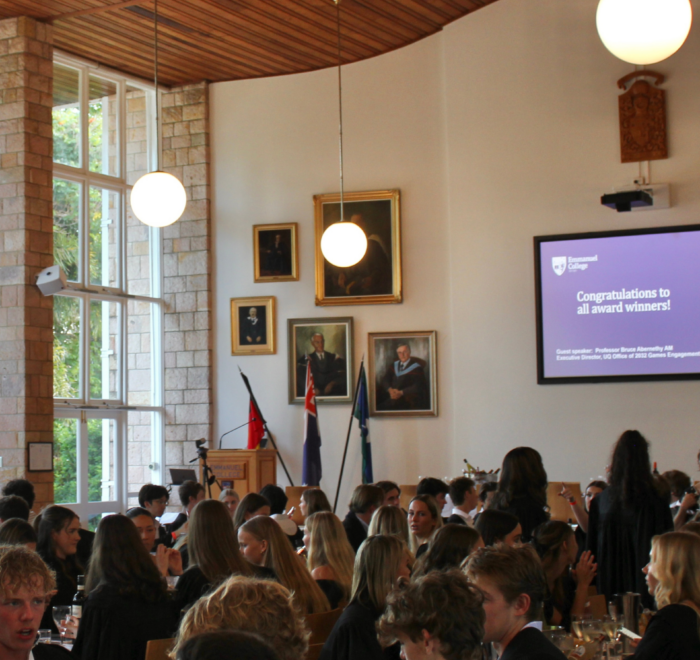Emmanuel expanded in the 1930s, growing to be the largest of the six UQ colleges. Major renovations were completed, including the remodelling and cement rendering of the original building in 1931 and the addition of a new wing to accommodate more students in 1936. The College magazine of that year notes:
“The Council has ever had an eye to the comfort and convenience of students, and all the changes have meant improved facilities for the fuller enjoyment of a social and corporate life … the tangible growth of buildings represents a spiritual, moral and educational development.”
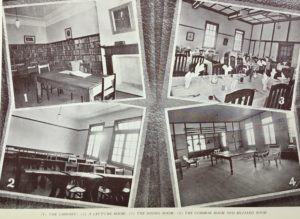
Emmanuel College student facilities in 1936: 1. Library; 2. Lecture Room; 3. Dining Room; 4. Common Room
The enthusiasm for sports, for the thrill of competition and the joy of college spirit, continued apace. In 1929 Emmanuel had won the Inter-College Competition for the first time and was again awarded the cup in 1931. A clean sweep of ICC sports came in 1932; Emmanuel won the premiership of every sport — cricket, tennis, rugby, rowing, athletics and swimming.
In 1936 Emmanuel reached the milestone of a quarter of a century. Two of the 56 students in residence that silver jubilee year would go on to graduate with academic honours, serve their country, establish families, develop distinguished careers, give back to the community and maintain their connections with Emmanuel to leave lasting legacies.
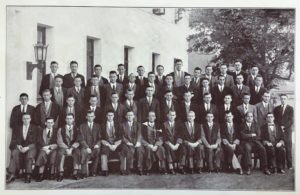
Emmanuel College 1936 – students Graeme Wilson and Harry Gibbs are in the third row, second from left and eighth from left respectively
Graeme Wilson was a student at Emmanuel from 1936 to 1939, studying Agricultural Science at UQ. An athlete and a scholar, Graeme represented Australia at the British Empire (now Commonwealth) Games in 1938 and graduated with a University Medal in 1939. He was awarded a Rhodes Scholarship, one of number awarded to Emmanuel students over the years, for 1940. However, he deferred his studies at Oxford University to serve in the Australian Army in World War II. After Oxford, Graeme returned to Brisbane and went on to become Professor of Agriculture at UQ.
A lifelong environmentalist, Graeme championed habitat regeneration and natural ecosystems long before people were active in, let alone aware of, conservation and sustainability. Emmanuel’s students of today nominate sustainability as their main value. Their commitment at College is borne out by activities such as reducing food waste and single-use plastics, recycling, participating in Clean Up Australia, planting wildlife corridors along the riverbank and establishing a community garden — actions that Graeme would, no doubt, endorse.
Graeme’s many years of community service and volunteer work were recognised in 2013 with the Brisbane Lord Mayor’s Senior Citizen of the Year award. He passed away in 2016 at the age of 99, survived by his wife Joy and their three children. Emmanuel honours his spirit of service through the Graeme Wilson Prize awarded annually to a student for all-round excellent contribution to the College and the wider community at our annual Bannockburn Community Awards.
Harry Gibbs resided at Emmanuel from 1934 to 1940 throughout his arts, law and postgraduate studies. He was admitted as a barrister in 1939 and practiced briefly before enlisting in the army, serving until 1945. Harry married Muriel Dunn, who had also studied law at UQ, in 1944. They had three daughters and one son. Harry’s reputation as an advocate and lawyer grew and he was appointed Queen’s Counsel in 1957, while also lecturing in the UQ Faculty of Law.
Harry’s judiciary career commenced in 1961 when he was appointed a Judge of the Supreme Court of Queensland. Two decades later Sir Harry Gibbs GCMG AC KBE QC was appointed Chief Justice of the High Court of Australia. He was the highest-ranking judicial officer in the land from 1981 to 1987, when he reached the statutory retirement age of 70. In retirement, Sir Harry was Chair of Australians for a Constitutional Monarchy. Further details of his many achievements are detailed by the Supreme Court Library Queensland. A strong supporter of the collegiate ideal, Sir Harry gave his blessing to the establishment of the Sir Harry Gibbs Law Scholarship at Emmanuel College shortly before he passed away in 2005, aged 88.
Wars, as they are wont to do, interrupt livelihoods and lives. World War II (1939-1945) also disrupted the very fabric of the College and the University.
Brisbane was home to the WWII headquarters of the Allied South West Pacific Area command under US General Douglas MacArthur from 1942 to 1944. An expansive site was needed for the Advanced Land Headquarters. In 1937 The University of Queensland, having outgrown its inner-city George Street location, had started construction on the new campus at St Lucia. From the middle of 1942 until the end of 1944 the entire St Lucia site was requisitioned by the Australian Army.
Back on Wickham Terrace, half of Emmanuel’s students had enlisted in the war and the College’s buildings were also commandeered by military authorities. In 1942 Emmanuel became a billet centre for the Australian Women’s Army Service (AWAS) — women had breached the all-male bastion! For the next three and a half years Emmanuel’s remaining students, whose numbers had decreased from 78 to 28, lived at Harrow guest house at 59 Leichhardt Street in Spring Hill.
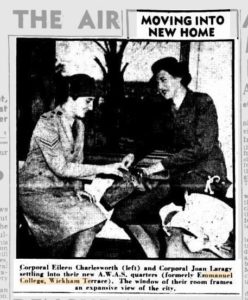
1942 newspaper clipping of Australian Women’s Army Service members billeting at Emmanuel College during World War II
With the end of the war, Emmanuel’s students returned. Some ten years later, Principal Henderson recalled: “In 1946 we returned to the College and what a joy it was to welcome back into residence so many of our old students who had served in the war.”
But amidst that great joy there was immense grief. Another generation had been lost to war and among them were nine Emmanuel students: Herbert Barnard Armstrong, James Austin, George Douglas Rutherford Avery, John Stuart Boden, Kelvin Reginald Boys, Ian Clarke Dunn, Neville Leonard Harpham, Murdo Donald Davidson Macfarlane, Geoffrey George Minchin Smith. Lest we forget.
Graham Thomson AM, one of Emmanuel’s much-loved and respected senior alumni, was a fresher in 1947. Graham shares his fond memories of that formative post-war year:
“The 75 students in residence were a mixed lot. There were 32 freshers, young and mostly from private schools. Several, including myself, were a little older. There was a group of ex-servicemen from the Navy, Army and RAAF. One, Harry West, was an ex-RAAF Squadron Leader in his late twenties. Harry sported a rather striking moustache. One of the initiation practices new students had to undergo was having the part in one’s hair substantially widened. The hair remover took pity on Harry and only shaved off half his moustache!”
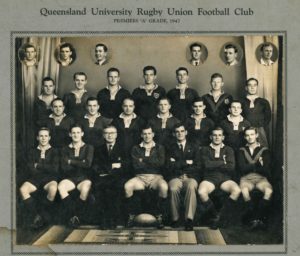
Emmanuel College fresher and member of the UQ Rugby premiership team Graham Thomson (front row, far right) in 1947
“The returning students were of different years of study across a number of disciplines. This diversity of age and background provided ample opportunity for a wide inter-change of opinions, ideas, experience and conversation. This situation made nightly suppers in the sparsely furnished Common Room interesting and sometimes vigorous. Many battles were re-fought by the ex-servicemen, and age and experience were learning opportunities for not only immature freshers, but also for others seeking advice and assistance. Emmanuel was a little society within itself. Living so closely together with regular daily contact inspired conviviality and the growth of lifelong friendships.”
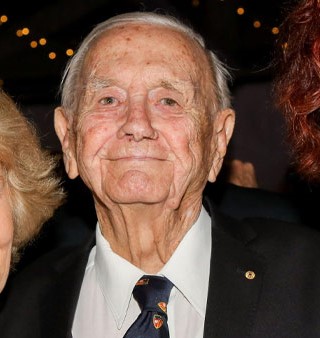
Graham Thomson AM in 2017
Planning for UQ’s relocation to St Lucia resumed in the mid-1940s. The colleges were part and parcel of the move, with sites allotted by the UQ senate.
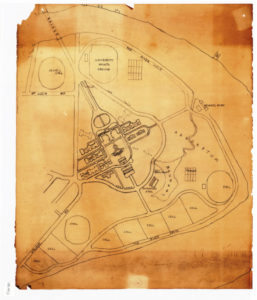
Concept map of The University of Queensland at St Lucia c. 1936 showing sites allotted for the colleges (“COLL”)
Once again, Emmanuel needed philanthropic support and, once again, looked to the Presbyterian Church community for help. And now, there was another supporter group the College could rely upon: our alumni. A fundraising appeal promoted in newspapers throughout Queensland rallied the church and alumni communities to action:
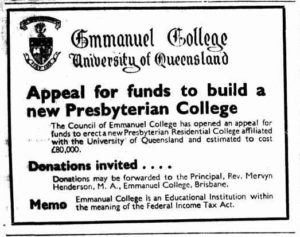
1945 newspaper advertisement for fundraising appeal to build a new Emmanuel College at St Lucia
“The £80,000 appeal to build the new Emmanuel College in the vicinity of the new University at St Lucia is to enable the Presbyterian community to continue, on a larger scale, the good work which has been carried on by the present Emmanuel College. The advantages of residence in a college have been found to be many, and a considerable number of old students have written from time to time to testify how much they owe to their years at Emmanuel. The effect of living from three to six years amongst students of all faculties broadens the outlook and proves of immense value in after life.”
The words “after life” here bear some contemplation. At first reading, it is understood to mean after student life. It can also allude to the hereafter. Perhaps considering Emmanuel — “God with us” — both meanings could be inferred.
